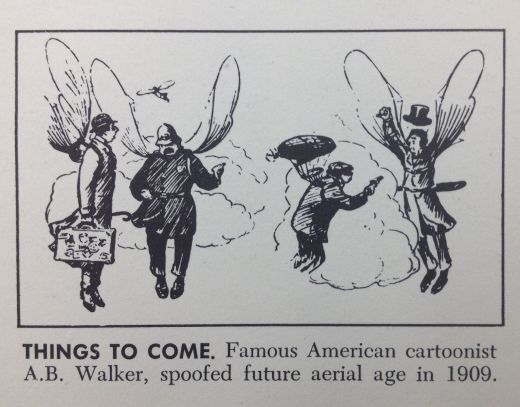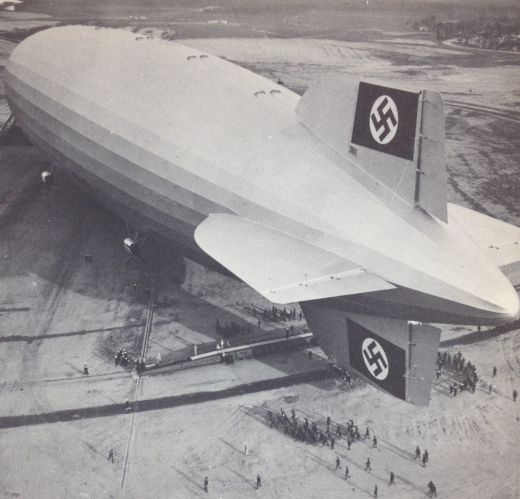A History of Human Flight in 58 Bullets
Rob Goyanes

Image from Wonderful Balloon Ascents: or, The Conquest of the Skies. A History of Balloons and Balloon Voyages. C. Scribner & Co., 1870. Courtesy Special Collections, University of Miami Libraries
—MOZI, 470–391 BC
Early Beginnings: Mythic Sparks and a Daredevil Monk
• ~6 MILLION YEARS AGO: The earliest ancestors of humans look up and see birds flying in the sky. There is no going back.
• BETWEEN 500,000 AND 91,000 YEARS AGO: We learn how to throw rocks and spears through the air to kill our prey. The first employment of projectiles, this is the earliest technological step in what will prove to be a very slow escape from gravity’s prison.
• BETWEEN 45,000 YEARS AGO AND 5000 BC: So begins the long and very uneven drag toward the knowledge and vessel production needed for flight: sailing is developed. There are different theories about the “first” use of advanced seafaring technology—it could explain Australia’s inhabitation, or it was a civilization on the Arabian Sea, or on the Bay of Bengal, or it was the Egyptians, or maybe it was the Chinese—some European people possibly. Or aliens, perhaps.
• ~400 BC: Mozi, a Chinese philosopher and technician whose Mohism school of thought called for an end to the ritual dependence and structures of Confucianism, creates the first credible kite. Eagle-shaped, the kite flew for a full day. Mozi’s precocious student, Lu Ban, in turn made a kite that flew for three days. Unimpressed, or secretly jealous, or saying something deeper and different altogether, Mozi responded, “Your accomplishment in constructing a bird does not compare with that of the carpenter making a linchpin.“
• 8 AD: The Greek poet Ovid publishes his Metamorphoses, in which he writes about Daedalus, the mythological artist/ architect/craftsman on retainer for King Minos of Crete. Minos, the son of Europa and Zeus, prayed to Poseidon for victory during his ascent to power. He asks Poseidon to send a white bull as a show of support, which Poseidon does with one qualification: Minos must sacrifice it as a display of honor. Minos, however, foolishly decides to keep it, because hen finds it just too beautiful. This move by Minos pisses Poseidon off, so he punishes Minos by casting a spell on his wife Pasiphaë, one that makes her lust after the bull. Pasiphaë, consumed with desire, commissions Daedalus (behind Minos’s back) to build a wooden cow suit so that she can secretly copulate with the bull. Around nine months later, Pasiphaë gives birth to a monster that is part-man, part bull, who is named the Minotaur. King Minos, cuckolded and disgusted with the creature, commissions Daedalus to build a prison for the Minotaur. Daedalus and his son Icarus design the labyrinth—a structure so complex that even the two builders have a hard time getting out. The Minotaur is put away and fed citizen-subjects as votive offerings. Long story long, the increasingly paranoid King Minos locked up Daedalus and Icarus in a tower so they couldn’t reveal the secrets of the labyrinth. Daedalus, in a move of logic that will repeatedly cause the delay of flight for millennia to come, built two sets of wings out of wax and feathers, and Icarus is the first to leap. Despite the advice of dad, he flies too close to the sun, so the wax melts, Icarus plummets into the water, and drowns.
• 850: Taoist alchemists in China experiment with chemicals in an effort to produce an elixir that will give everlasting life. The ingredients of this elixir, ironically, turn out to be the mixture required for
gunpowder.
• 852: Córdova, a medieval Muslim state and Caliphate in al-Andalus (Andalusia of present-day Spain and Portugal), is a cultural and scientific epicenter. Abbas Ibn Firnas, a poet, musician, and inventor of many things including “reading stones” (early glasses lenses), attempts flight with some vulture feathers and two wings. He suffers serious injuries that lead to his death years later. Also, a crater on the moon is named after him (as is an airport in northern Baghdad).
• 1010: Eilmer of Malmesbury, a Benedictine Monk, is inspired by the story of Daedalus (and possibly that of Firnas), and jumps out of a tower with a pair of wings. He sustains flight for a couple of seconds—then a pair of broken legs.
Fireworks, Balloons, Rockets, and Sky Ships: The Middle Period of Flight
• 1212 OR 1264: The first use of a true rocket occurred in China sometime in the thirteenth century. The first mostly reliable record we have of an internal-combustion rocket propulsion device is a firework used at a grand feast held by Emperor Lizong.
• 1419: Bohemia was a real place, a Holy Roman territory ruled by the Hapsburgs in the current-day Czech Republic. In Prague, the capital, a group of Czech Hussites—a radical Christian group who were forerunners of the Protestant Reformation—stormed the New Town Hall after a rock was thrown at them from the tower during a political procession and defenestrated Roman Catholic officials (threw them out the window).
• ~1485: Leonardo da Vinci draws up plans for his human-powered ornithopter, a winged device that requires users to flap like a bird. Though still based on the faulty bird-logic, da Vinci is on to something by using math and physics to inform his design.
• ~1500: Wan Hu, a Chinese bureaucrat, attempts to fly using a chair, some kites, and forty-seven rockets. Things don’t end well.
• 1591: Johann Schmidlap, a German fireworks maker, successfully flies a multi-stage rocket (little rockets applied to a bigger rocket).
• 1670: Italian Jesuit Francesco Lana de Terzi publishes a description of an “Aerial Ship” using copper spheres/balloons as the means for flight.
• 1680: Tsar Peter the Great establishes the first rocket factory in Moscow, where signal and illuminating rockets are created for the Russian army.
• 1783: A big year for balloons, the French are at the forefront of the form. Starting with the Montgolfier brothers at Versailles, they perform the first aerostatic balloon flight. The first balloon passengers are a sheep, a duck, and a cockerel. After this, Jean François Pilâtre de Rozier performs the first manned balloon flight. This is also the year when Les Fréres Robert (the Robert brothers Anne-Jean and Nicolas-Louis) made the first hydrogen balloon, which was attacked by paranoid villagers after it crashed.
• 1785: Jean-François Pilâtre de Rozier (mentioned above) dies in an attempt to fly across the English Channel. He and his buddy Pierre Romaine are the first casualties by air.
• 1797: The first successful parachute descent is performed by André-Jacques Garnerin.
• 1852: Frenchman Henri Giffard is the first to fly in an engine-powered (steam) ship.
• 1873: The term “aviation” is coined by Guillaume Joseph Gabriel de La Landelle, a French writer who was a naval officer stationed in South America before he devoted himself fully to literature and journalism. He wrote maritime adventure novels. The components of “aviation” are avier, the French verb for flying, and –ation, the suffix denoting action.
• 1884–85: A. F. Mozhaysky, a Russian naval officer, tests a heavier-than-air craft. The steam-powered monoplane does not successfully obtain lift.
• 1891: German engineer Otto Lilienthal starts experimenting with a pair of fixed wings, eventually becoming the first person to successfully and repeatedly fly (and document it, too) after jumping off of towers and various hills of Rhinow, near Berlin. These wings do not flap—they glide.
• 1896: Lilienthal breaks his neck during a routine flight (goes to beg: is anything routine?). His last words are “Opfer müssen gebracht werden!” (Sacrifices must be made!).
• 1903: Orville and Wilbur Wright fly a gas-powered airplane at Kitty Hawk for thirty-five meters. It is the first heavier-than-air controlled flight.
• 1909: The Rheims first international flight competition is held.
• 1913: Igor Sikorsky flies his Russky Vityaz, the first multi-engine, fixedwing, heavier-than-air craft.
Modernity is a Pie in the Sky Best Served Cold
• 1914: With the outbreak of World War I comes the arrival of aerial machines of war. Propagandists, artists, and the newly forming media networks of radio and mass print distribution reflect a period of fear, wonder, and appropriation of technology as a means for formulating identity. Warplanes become a fixture of the American, German, and Russian consciousness.
• 1918: The Central Aerohydrodynamic Institute (TsAGI) is founded in Moscow by Nikolay Zhukovsky.
• 1921: Vladimir Lenin signs a drafted document titled “About Air Transportation,” which lays out some of the basic regulations regarding air transport over the USSR. Significant because it was the first assertion of Soviet sovereignty over its air space, it was part of the early wave of regime-making concerning notions of nonterrestrial territory.
• 1925: Pioneering aircraft designer Andrei Tupolev designs a twin-engine angular monoplane bomber, the highly advanced TB-1, which composes the majority of the USSR’s bomber fleet.
• 1930s: Stalin’s Five-Year Plan is enacted and includes provisions to radically modernize manufacturing and industry, especially the military. Engineers, scientists, and technicians are held in a Gulag where, instead of mining coal or lumbering timber, they are forced to produce new (or recreate Western) inventions and scientific achievements. Planes of war are a primary focus.
• 1937: Amelia Earhart, the first female aviator to travel solo across the Atlantic Ocean, disappears somewhere in the Pacific Ocean during an attempt at a circumnavigational flight around the world. This is the same year that the Hindenberg—a German passenger airship—explodes in a fiery blaze in New Jersey.
• 1941: Japan launches a surprise strike from the air on the Pearl Harbor naval base. The United States is stunned by the aerial assault for its destructive effect, both real and temporal.
• 1945: Following the end of World War II, the United States evacuates/forcibly removes a cadre of German scientists: rocket scientists, engineers, physicists, opticians, in the formally dubbed Operation Paperclip. What had started as the capture and interrogation of scientists before the end of the war, turned into an effort to skim top rocket talent for domestic production, achieved with a mix of threat and promise. Wernher von Braun, German designer of the V-2 rocket—the first long-range guided ballistic missile—is among the 1,500 or so scientists. A former member of the Nazi Party and SS, von Braun goes on to a long and esteemed career, designing ICBMs and later developing the Saturn V launch vehicle, the superbooster that jettisoned Apollo to the moon.
• 1942: The British develop a secret project to make an aircraft that can break the sound barrier. The project is canceled before it can be achieved. They do, however, make a missile that breaks this aerohydrodynamic wall.
• 1947: The first Supersonic speed tests are performed by the Soviet TsAGI using wind tunnels.
• 1947: The first of the so-called X series of planes, the United States begins experiments with manned supersonic flight using the Bell X-1 and a man named Chuck Yeager. During the historic flight, Yeager was in severe pain from two broken ribs after falling off a horse a couple nights before. Fearing the mission would be postponed or canceled, he had sought treatment at the local veterinarian’s office.
• 1948–49: Berliners undergo an occupation of their city by the Soviet Union in the East, and the Allies in the West. With competing economic ideologies, the Soviets block access to Allied-controlled areas, offering to end it if the newly introduced Deutschmark is abolished. The first incident of the hallucinogenically nonviolent confrontation of the Cold War, the Allies fly more than 200,000 flights into West Berlin, providing food and other necessities, without any military response by the Soviets.
Spectacular Jet Age: Tourism, Terror, and the Great Beyonds
Aircraft and people both have a fate, happy or otherwise.
YEFIM GORDON AND KEITH DEXTER,
MIKOYAN MIG-21
• 1952: The first commercial jetliner—the de Havilland DH 106 Comet—is unveiled for public use.
• 1953: The Empress of Hawaii, a DH Comet 1A flown by Canadian Pacific Airlines, fails to get airborne during a takeoff at night out of Karachi, Pakistan, and crashes into the embankment of an empty drainage canal and kills the five crew members and six passengers on board. They are the first casualties in the history of casualties caused by jetliners.
• 1954: The Soviet Union develops the MiG-21 fighter jet, which will go on to become known as the “people’s fighter.”
• 1957: The International Geophysical Year is established. Lots of stuff is done by an international consortium of scientists utilizing the technologies that had been developed and advanced during WWII: Submarine ridges are discovered, thus further confirming the theory of tectonic plates; extensive deep measurements of the polar ice caps; detection of dangerous radiation in space; and the launch of Sputnik by the Soviet Union, which totally freaks out Americans and prompts the “Space Race.”
• 1958: NASA is established, and Americans promptly put Explorer I into orbit.
• 1960s: Convair B-58 Hustlers, the first supersonic fighter bombers to hit Mach 2, are flown back and forth across the United States and around the world. The US Air Force receives over 10,000 claims of broken windows from homeowners.
• 1961: Yuri Gagarin, a Russian cosmonaut, becomes the first human in outer space when he and his Vostok 3KA orbit the Earth.
• 1963: Valentina Tereshkova is the first woman in outer space. She logs over three nauseous days above the Earth, which is more than the total combined times of every American (man) to go before her.
• 1969: Apollo 11 lands on the moon. Neil Armstrong steps onto its surface, as 500 million people watch its live broadcast.
• 1971: In the return of the mission to dock the first space station (the Soviet Salyut 1), the Russian crew of the Soyuz 11 dies during their return flight due to improper decompression. They—Georgy Dobrovolsky, Vladislav Volkov, and Viktor Patsayev—are the only humans (currently) to have ever died outside the Earth’s atmosphere.
• 1978: Carl Boenish performs and films the first BASE jumps from El Capitan, the granite monolith in Yosemite National Park.
• 1983: A Soviet Su-15 interceptor accidentally shoots down Korean Air Lines Flight 007, which was on its way from New York to Seoul.
• 1986: The Challenger space shuttle disintegrates seventy-three seconds after takeoff.
• 1998: The construction of the International Space Station begins.
• 2001: A coordinated attack by the terrorist group al-Qaeda is carried out on the United States with four hijacked passenger jets. The only American not on the planet at the time was the astronaut Frank Culbertson, who was stationed on the International Space Station with three cosmonauts. They watched the plumes of smoke from space, and noted the near total absence of plane trails that are otherwise always visible over the American landmass.
• 2010: SpaceX becomes the first (and still only) private company to launch (and return) a vehicle into/ from low Earth orbit.
• 2014: Malaysia Airlines Flight 370 disappears without a trace somewhere in the Indian Ocean.
• 2014: Russian-backed Ukrainian separatists accidentally shoot down Malaysia Airlines Flight 17.
• 2015: A depressed Germanwings pilot by the name of Andreas Lubitz flies himself and 149 passengers into a mountain range of the French Alps.
• 2015: Get up after reading this and lay flat on the floor, with your arms and legs spread out. Notice the pull of gravity, the hardness of the earth against you—the invisible grip—and what do you feel? Pain, or comfort?
This text is an excerpt from Goyanes’s first book, Balalaika: An Owner’s Manual for Asif Farooq’s MiG-21.
Major parts of the research for this piece were conducted at the University of Miami Library’s Special Collections, at the National Museum of the United States Air Force, on the Internet, and at Bookleggers, so many thanks to each.
ROB GOYANES writes for the Miami Rail,
Paris Review (forthcoming), and others. He
is currently the writer-in-residence at the de
la Cruz Collection.













